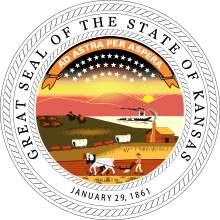Sunflower Army Ammunition Plant

The Sunflower Army Ammunition Plant (or SFAAP) was a smokeless powder and propellant manufacturing facility in northwest Johnson County, Kansas, south of De Soto, owned by the United States Government and operated under contract, primarily by Hercules Aerospace Company.
History
The Sunflower Army Ammunition Plant was originally known as the Sunflower Ordnance Works. Established in 1941 on 10,747 acres (43.492 km²), it was the world's largest smokeless powder plant. Although owned by the U.S. government, the plant was operated by the Hercules Powder Company under a contract signed on May 11, 1942. Construction then began immediately and was followed by the first production of propellant 10 months later.
During World War II, the Sunflower Ordnance Works produced more than 200 million pounds (91,000,000 kg) of propellants and employed as many as 12,067 people. Following the war, the plant was placed on partial standby. And in March 1947, the contract with Hercules Powder Company expired. When the plant was placed on complete standby in June 1948, the government took over maintenance and security.
In 1951, the Sunflower Ordnance Works was brought out of standby due to the Korean War. Once again, on June 30, 1952, the operation of the plant was contracted out to Hercules. This time the plant produced more than 166 million pounds (75,000,000 kg) of propellants, with employment of up to 5,374. The plant then went into standby again in June 1960.
The name of the plant was changed from the Sunflower Ordnance Works to Sunflower Army Ammunition Plant (SFAAP) on August 1, 1963. Two years later, on August 20, 1965, the plant was reactivated to aid the Vietnam War by producing in excess of 145 million pounds (66,000,000 kg) of propellants before ceasing operations in June 1971. While operating during this time, the plant employed up to 4,065 people. In 1972, the plant was returned to standby status.
A major facility modernization program was started in August 1967. The program included the construction, between 1975 and 1979, of a facility for the production of nitroguanidine. This facility was the first of its kind in North America and began production in 1984 and continued until 1992, when the plant was again placed on standby. Nitroguanidine (NQ) is an essential component of triple-base gun propellant. In addition to being an oxidizer and energy carrier, it is loaded with hydrogen and this provides cooling in the gun tube which reduces the erosion rate of the tube metal so more rounds can be fired before refit. NQ was shipped out in fiberboard drums to another army facility where the triple-base is prepared,
Alliant Techsystems won a contract on March 10, 1995 to market the use of the Sunflower Army Ammunition Plant facilities. Also in February 1995, the Environmental Protection Agency proposed that the site be placed on the National Priorities List, but it was never listed. Early in 1998, SFAAP was declared excess by the U.S. Army, and the General Services Administration began the process of selling the site. As of October 1, 2001, the Army changed to a maintenance contractor and reduced the number of buildings used to an office building, an environmental laboratory, the old guard headquarters as a records repository, and the guard shack at the main gate.[1]
The Sunflower Army Ammunition Plant rail system was operated under contract by Hercules, Inc. The system included 59 miles of track, with rails ranging in size from 85 to 100 pounds (per yard) connecting with BNSF Railway, and the enginehouse was Building 501. Operations were conducted from Monday through Friday, 0800 to 1600 with a GE 80-ton locomotive number US Army 1662. Formerly assigned to Letterkenny Army Depot, PA, the locomotive went from Sunflower AAP to McAlester AAP, OK, where it was reported to being shipped to Senaca Army Depot, NY, in October 1999. When Seneca AD closed, the locomotive was sold to the Dominican Republic. All of the track at Sunflower AAP was pulled up following the plant's closure.
References
- ↑ "Public Health Assessments & Health Consultations - Sunflower Army Ammunition Plant Sunflower Army Ammunition Plant Consent Order No. 05-E-0111". Agency for Toxic Substances and Disease Registry. 28 July 2005. p. 86. Retrieved 4 May 2010.
Further reading
- THOMAS DAVID VAN SANT (1989). "Price of victory : the Sunflower Ordnance Works and Desoto and Eudora Kansas" (M.A. thesis). KANSAS STATE UNIVERSITY. Retrieved 26 February 2015.
- MICHAEL MANSUR, (March 9, 1991). "KU To Do Testing at Dump in County". THE KANSAS CITY STAR. Retrieved 26 February 2015. KU disposed of radioactive waste west of the Sunflower Army Ammunition Plant
- "U.S./Kansas Propose Landmark Property Transfer At Sunflower Ammunition Plant". GSA.gov. June 14, 2000. Retrieved 26 February 2015.
- Dave Ranney (October 3, 2001). "AG rules Oz must repay BPU". The World Company. Retrieved 26 February 2015. Wonderful World of Oz theme park
- "Sunflower Vol. 2". About Sunflower AAP. GSA property disposal. Retrieved April 28, 2005.
- "Sunflower Redevelopment on Hold Again". Association of Defense Communities (ADC). March 16, 2011. Archived from the original on 26 February 2015. Retrieved 26 February 2015.
- "Sunflower Army Ammunition Plant Records (2005.103) Date Span: 1942-2003" (PDF). www.jocogov.org. Johnson County Museum and partners. 2008. p. 7. Retrieved 26 February 2015.
- "NPL Site Narrative for Sunflower Army Ammunition Plant". EPA. 27 November 2012. Retrieved 26 February 2015.
- Steve Kraske & Beth Lipoff (October 10, 2013). "Looking Back At The Sunflower Ammunition Plant" (34 min audio clip). KCUR.org. Kansas City Public media. Retrieved 26 February 2015.
- DIANE STAFFORD (27 August 2013). "A look back at Sunflower Ordnance". Kansas City Star. Retrieved 26 February 2015.
- Matt Gilligan (February 18, 2014). "Sunflower Army Ammunition Plant: A City Unto Itself. Exhibit "Citizen Soldiers on the Prairie"". JoCoHistory.org. Johnson County Museum and partners.
External links
- Google Maps Satellite Image
- Historic American Engineering Record (HAER) No. KS-3, "Sunflower Army Ammunition Plant, De Soto, Johnson County, KS", 64 data pages
Coordinates: 38°56′01″N 95°00′27″W / 38.9336°N 95.0076°W
